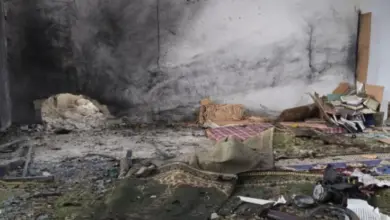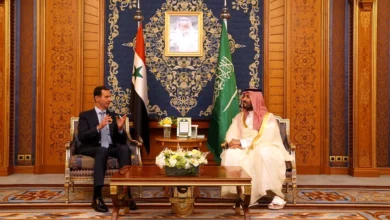
BEIRUT — Syrian gunners pounded an opposition stronghold Wednesday where the last dispatches from a veteran American war correspondent chronicled the suffering of civilians caught in the relentless shelling. An intense morning barrage claimed her life as well as that of a French photographer.
In all, more than 70 people were killed nationwide as President Bashar al-Assad's regime also escalated attacks on rebel bases elsewhere, with helicopter gunships strafing areas in the northwest, activists said.
Marie Colvin, who was working for Britain's Sunday Times, and photojournalist Remi Ochlik were among a group of journalists who had sneaked into the country and were sharing accommodations with activists in the embattled city of Homs, raising speculation that Syrian forces targeted the makeshift media center although opposition groups had previously described the shelling as indiscriminate.
The weeks of siege-style attacks on Homs — that have killed hundreds- has come to symbolize the desperation and defiance of the more than 11-month uprising against Assad's rule.
"I watched a little baby die today," Colvin told the BBC on Tuesday from Homs.
"Absolutely horrific, a 2-year old child had been hit," she said. "They stripped it and found the shrapnel had gone into the left chest and the doctor said, 'I can't do anything.' His little tummy just kept heaving until he died."
The Syrian military appears to be stepping up assaults to block the opposition for gaining further ground and political credibility with Western and Arab nations. On Wednesday, helicopter gunships reportedly strafed mountain villages that shelter units of the rebel Free Syrian Army, and government soldiers staged door-to-door raids in Damascus, among other attacks.
The bloodshed and crackdowns brought some of the most galvanizing calls for the end to Assad's rule as the Syrian opposition increasingly raises its international profile.
The US and other countries have begun to cautiously examine the possibility of military aid to the rebels, and US Secretary of State Hillary Rodham Clinton was traveling to Tunisia for a meeting Friday of more than 70 nations to look at ways to assist Assad's opponents, which now include hundreds of military officers and soldiers who defected.
"That's enough now. The regime must go," French President Nicolas Sarkozy said after his government confirmed the deaths of Colvin, 56, and Ochlik, 28. At least two other Western journalists were injured in the shelling — French reporter Edith Bouvier of Le Figaro and British photographer Paul Conroy of the Sunday Times.
A statement by Syria's Minister of Information, Adnan Mahmoud, said there was "no information" about Colvin, Ochlik and other foreign journalists in Syria who entered without official permission, the state-run news agency SANA reported. It warned all foreign journalists to come forward to "regularize their status."
In Saudi Arabia, the state news agency described King Abdullah as scolding Russia's President Dmitry Medvedev — one of Assad's few remaining allies — for joining China in vetoing a UN Security Council resolution earlier this month condemning the violence in Syria.
But even Moscow said Wednesday the ongoing bloodshed adds urgency for a cease-fire to allow talks between his regime and opponents.
Washington had strongly opposed arming anti-Assad forces, fearing it could bring Syria into a full-scale civil war. Yet the mounting civilian death tolls — at least 74 in total across Syria on Wednesday, activists said — has brought small but potentially significant shifts in US strategies. It remains unclear, however, what kind of direct assistance the US would be willing to provide.
The toppling of Assad also could mark a major blow to Iran, which depends on Damascus as its main Arab ally and a pathway to aid Iran's proxy Hezbollah in Lebanon.
"We don't want to take actions that would contribute to the further militarization of Syria because that could take the country down a dangerous path," White House press secretary Jay Carney told reporters. "But we don't rule out additional measures if the international community should wait too long and not take the kind of action that needs to be taken."
The UN estimated in January that 5,400 people have been killed in repression by the Assad regime against what began 11 months ago as a popular uprising. Syrian activists, however, put the death toll at more than 7,300.
An opposition group, the Local Coordination Committees, said at least 74 people were killed around the country, including 29 in Idlib, 20 in Homs, 13 in Hama and others scattered elsewhere. The overall figures could not be independently confirmed as Syrian authorities ban most journalists from working in the country.
Homs — with its force of breakaway soldiers — has emerged as a major center of resistance that has drawn comparisons to the Libyan city of Misrata, which withstood withering attacks by government troops during last year's uprising that led to the ouster of Muammar Qadhafi.
In one tragic image, a man with a bandaged head is shown cradling the face of his son, who was purportedly killed by Syrian government shelling in Homs on Saturday. The video image was released by activists Wednesday and the details could not be confirmed.
Colvin described seeing a 2-year-old child killed Tuesday and it did not appear to be related to the video image.
"It is a city of the cold and hungry, echoing to exploding shells and burst of gunfire," wrote Colvin in a newspaper story published Sunday. "There are no telephones and the electricity has been cut off. Few homes have diesel for the tin stoves they rely on for heat in the coldest winter that anyone can remember."
Amateur video posted online shows the two injured journalists in a makeshift clinic, lying on two separate beds. The French journalist, Bouvier, had her left leg covered from the thigh down in a cast. A doctor in the video explains that she needs emergency medical care. Conroy appears in the video and doctors say he has deep gashes in his left leg.
A Homs-based activist, Omar Shaker, said the journalists were killed when several rockets hit a garden of a house used by activists and journalists in the besieged neighborhood of Baba Amr. Shaker said tanks and artillery began intensely shelling at 6:30 am and continued hours later. He said the room used by journalists was hit around 10 am
An amateur video posted online by activist showed what they claimed were bodies of the two journalists in the middle of a heavily damaged house. One of the dead was wearing what appeared to be a flak jacket.
The intense violence in parts of Homs — with blasts occurring sometimes just a few seconds apart — has appeared to be have had no clear pattern over the past week, hitting homes and streets randomly. Some suggested, however, that the house used by the journalists and activists was pinpointed by Syrian gunners, perhaps by following the signals from satellite phones and other communications equipment.
French Culture Minister Frederic Mitterrand claimed the journalists were "pursued" as they tried to find cover, but did not elaborate. A campaigner for online global activist group Avaaz, Alice Jay, claimed the group was "directly targeted."
Another Avaaz activist, Alex Renton, claimed seven Syrians trying to reach Baba Amr with medical supplies and a respirator were found with their hands tied behind their backs and shot dead. Two other activists, including a foreign paramedic, traveling with the seven are missing, he added. The claims could not be immediately confirmed.
Many foreign journalists have been sneaking into Syria illegally in the past months with the help of smugglers from Lebanon and Turkey. Although the Syrian government has allowed some journalists into the country, their movement is tightly controlled by Information Ministry minders.
Colvin, from East Norwich, New York, was a veteran foreign correspondent for the Sunday Times for the past two decades. She was instantly recognizable for an eye patch worn after being injured covering conflicts in Sri Lanka in 2001.
Ochlik, who had set up a photo agency, IP3 Press, won first prize in the general news category of the prestigious 2012 World Press Photo contest for his 12-photograph series titled "Battle For Libya."
"I just arrived in Homs, it's dark," Ochlik wrote to Paris Match correspondent Alfred de Montesquiou on Tuesday. "The situation seems very tense and desperate. The Syrian army is sending in reinforcements now and the situation is going to get worse — from what the rebels tell us."
"Tomorrow, I'm going to start doing pictures," he added.
Elsewhere, the military intensified attacks.
In the northwestern province of Idlib, a main base of the rebel Free Syrian Army, the Britain-based Syrian Observatory for Human Rights claimed that Syrian military helicopters fitted with machine guns strafed the village of Ifis. Syrian combat helicopters are primarily Russian-made, though Syria also has a number of French choppers.
The Local Coordination Committees said troops conducted raids in the Damascus district of Mazzeh and the suburb of Jobar, where dozens of people were detained. In Jobar, the group said troops broke down doors of homes and shops and set up checkpoints.
The group also said troops backed by tanks stormed the southern village of Hirak and conducted a wave of arrests.
On 11 January, award-winning French TV reporter Gilles Jacquier was killed in Homs. The 43-year-old correspondent for France-2 Television was the first Western journalist to die since the uprising began in March. Syrian authorities have said he was killed in a grenade attack carried out by opposition forces — a claim questioned by the French government, human rights groups and the Syrian opposition.
Last week, New York Times correspondent Anthony Shadid died of an apparent asthma attack in Syria after he sneaked in to cover the conflict.




